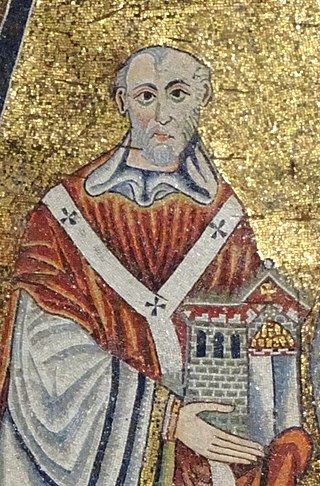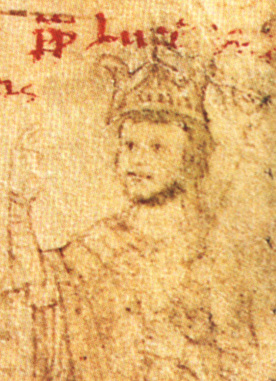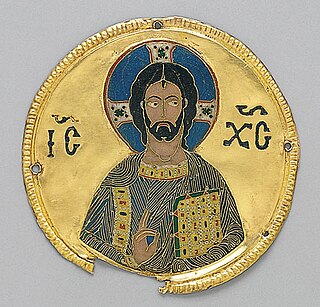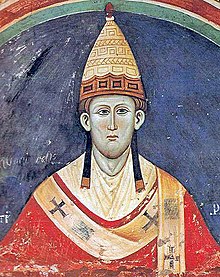
Pope Gregory X, born Teobaldo Visconti, was head of the Catholic Church and ruler of the Papal States from 1 September 1271 to his death and was a member of the Secular Franciscan Order. He was elected at the conclusion of a papal election that ran from 1268 to 1271, the longest papal election in the history of the Catholic Church.

Pope Innocent II, born Gregorio Papareschi, was head of the Catholic Church and ruler of the Papal States from 14 February 1130 to his death in 1143. His election as pope was controversial and the first eight years of his reign were marked by a struggle for recognition against the supporters of Anacletus II. He reached an understanding with King Lothair III of Germany who supported him against Anacletus and whom he crowned as Holy Roman emperor. Innocent went on to preside over the Second Lateran council.

Pope Innocent III, born Lotario dei Conti di Segni, was the head of the Catholic Church and ruler of the Papal States from 8 January 1198 until his death on 16 July 1216.

The Avignon Papacy was the period from 1309 to 1376 during which seven successive popes resided in Avignon rather than in Rome. The situation arose from the conflict between the papacy and the French crown, culminating in the death of Pope Boniface VIII after his arrest and maltreatment by Philip IV of France. Following the subsequent death of Pope Benedict XI, Philip forced a deadlocked conclave to elect the French Clement V as pope in 1305. Clement refused to move to Rome, and in 1309 he moved his court to the papal enclave at Avignon, where it remained for the next 67 years. This absence from Rome is sometimes referred to as the "Babylonian captivity of the Papacy".

Pope Lucius III, born Ubaldo Allucingoli, reigned from 1 September 1181 to his death in 1185. Born of an aristocratic family of Lucca, prior to being elected pope, he had a long career as a papal diplomat. His papacy was marked by conflicts with Holy Roman Emperor Frederick I, his exile from Rome and the initial preparations for the Third Crusade.
In English history, praemunire or praemunire facias refers to a 14th-century law that prohibited the assertion or maintenance of papal jurisdiction, or any other foreign jurisdiction or claim of supremacy in England, against the supremacy of the monarch. This law was enforced by the writ of praemunire facias, a writ of summons from which the law takes its name.

The Investiture Controversy or Investiture Contest was a conflict between the Church and the state in medieval Europe over the ability to choose and install bishops (investiture) and abbots of monasteries and the pope himself. A series of popes in the 11th and 12th centuries undercut the power of the Holy Roman Emperor and other European monarchies, and the controversy led to nearly 50 years of conflict.
Clericis laicos was a papal bull issued on February 5, 1296, by Pope Boniface VIII in an attempt to prevent the secular states of Europe—in particular France and England—from appropriating church revenues without the express prior permission of the pope. The two expansionist monarchies had come to blows, and the precedents for taxation of the clergy for a "just war" if it was declared a crusade and authorized by the papacy had been well established. The position of Boniface was that prior authorization had always been required and that the clergy had not been taxed for purely secular and dynastic warfare.
Gallicanism is the belief that popular secular authority—often represented by the monarch's or the state's authority—over the Catholic Church is comparable to that of the pope. Gallicanism is a rejection of ultramontanism; it has something in common with Anglicanism, but is nuanced, in that it plays down the authority of the Pope in church without denying that there are some authoritative elements to the office associated with being primus inter pares. Other terms for the same or similar doctrines include Erastianism, Febronianism, and Josephinism.
The Gregorian Reforms were a series of reforms initiated by Pope Gregory VII and the circle he formed in the papal curia, c. 1050–80, which dealt with the moral integrity and independence of the clergy. The reforms are considered to be named after Pope Gregory VII (1073–85), though he personally denied it and claimed his reforms, like his regnal name, honoured Pope Gregory I.

Unam sanctam is a papal bull that was issued by Pope Boniface VIII on 18 November 1302. It laid down dogmatic propositions on the unity of the Catholic Church, the necessity of belonging to it for eternal salvation, the position of the Pope as supreme head of the Church and the duty thence arising of submission to the Pope in order to belong to the Church and thus to attain salvation. The Pope further emphasized the higher position of the spiritual in comparison with the secular order. The historian Brian Tierney calls it "probably the most famous" document on church and state in medieval Europe. The original document is lost, but a version of the text can be found in the registers of Boniface VIII in the Vatican Archives. The bull was the definitive statement of the late medieval theory of hierocracy, which argued for the temporal as well as spiritual supremacy of the pope.
The Second Council of Lyon was the fourteenth ecumenical council of the Roman Catholic Church, convoked on 31 March 1272 and convened in Lyon, Kingdom of Arles, in 1274. Pope Gregory X presided over the council, called to act on a pledge by Byzantine emperor Michael VIII to reunite the Eastern church with the West. The council was attended by about 300 bishops, 60 abbots and more than a thousand prelates or their procurators, among whom were the representatives of the universities. Due to the great number of attendees, those who had come to Lyon without being specifically summoned were given "leave to depart with the blessing of God" and of the Pope. Among others who attended the council were James I of Aragon, the ambassador of the Emperor Michael VIII Palaiologos with members of the Greek clergy and the ambassadors of Abaqa Khan of the Ilkhanate. Thomas Aquinas had been summoned to the council, but died en route at Fossanova Abbey. Bonaventure was present at the first four sessions but died at Lyon on 15 July 1274. As at the First Council of Lyon, Thomas Cantilupe was an English attendee and a papal chaplain.
The Apostolic Camera, formerly known as the Papal Treasury, was an office in the Roman Curia. It was the central board of finance in the papal administrative system and at one time was of great importance in the government of the States of the Church and in the administration of justice, led by the Camerlengo of the Holy Roman Church, originally known as camerarius (chamberlain).
The assembly of the French clergy was in its origins a representative meeting of the Catholic clergy of France, held every five years, for the purpose of apportioning the financial burdens laid upon the clergy of the French Catholic Church by the kings of France. Meeting from 1560 to 1789, the Assemblies ensured to the clergy an autonomous financial administration, by which they defended themselves against taxation.
The Council of Bourges was a Catholic council convened in November 1225 in Bourges, France; it was the second largest church assembly held in the West up to that time, exceeded in the numbers of prelates that attended only by the Fourth Lateran Council. Summoned by the cardinal-legate Romanus Bonaventura, it was attended by 112 archbishops and bishops, more than 500 abbots, many deans and archdeacons, and over 100 representatives of cathedral chapters.

Christianity in the 11th century is marked primarily by the Great Schism of the Church, which formally divided the State church of the Roman Empire into Eastern (Greek) and Western (Latin) branches.

The War of the Keys (1228–1230) was the first military conflict between Frederick II, Holy Roman Emperor, and the Papacy. Fighting took place in central and southern Italy. The Papacy made strong gains at first, securing the Papal States and invading the Kingdom of Sicily, while Frederick was away on the Sixth Crusade. Upon his return, he defeated the papal forces, forcing Pope Gregory IX to begin peace talks. After drawn-out negotiations, the treaty of San Germano terminated the conflict with no territorial changes.
The oath of Bereg, also labelled as agreement at Bereg, was a treaty signed between the Kingdom of Hungary and the Holy See in the forests of Bereg on 20 August 1233. In the document, King Andrew II of Hungary vowed that he would not employ Jews and Muslims to administer royal revenues, which caused a decade-long discord with the Holy See starting in the early 1220s, composing of diplomatic complaints and ecclesiastical censures. The document is also an important source for the history of salt trade in Hungary.
Crusades against Christians were Christian religious wars dating from the 11th century First Crusade when papal reformers began equating the universal church with the papacy. Later in the 12th century focus changed onto heretics and schismatics rather than infidels. Holy wars were fought in northern France, against King Roger II of Sicily, various heretics, their protectors, mercenary bands and the first political crusade against Markward of Anweiler. Full crusading apparatus was deployed against Christians in the conflict with the Cathar heretics of southern France and their Christian protectors in the 13th . This was given equivalence with the Eastern crusades and supported by developments such as the creation of the Papal States. The aims were to make the crusade indulgence available to the laity, the reconfiguration of Christian society, and ecclesiastical taxation.
From the time of Constantine I's conversion to Christianity in the 4th century, the question of the relationship between temporal and spiritual power was constant, causing a clash between the Church and the Empire. The disappearance of imperial power initially enabled the pope to assert his independence. However, from 962 onwards, the Holy Roman Emperor took control of the papal election and appointed the bishops of the Empire himself, affirming the pre-eminence of his power over that of the Church. However, such was the stranglehold of the laity on the clergy that the Church eventually reacted. The Gregorian reform began in the mid-11th century. In 1059, Pope Nicholas II assigned the election of the pope to the college of cardinals. Then, in 1075, Gregory VII affirmed in the dictatus papae, stating that he alone possessed universal power, superior to that of the rulers, and withdrew the appointment of bishops from them. This marked the start of a conflict between the Papacy and the Emperor, which historians have dubbed the "Investiture Dispute". The most famous episode was Henry IV's excommunication and his penance at Canossa to obtain papal pardon. At the end of this conflict, the Pope succeeded in freeing himself from imperial guardianship. In 1122, under the Concordat of Worms, the Emperor agreed to the free election of bishops, reserving the right to give prelates temporal investiture. This compromise marked the defeat of the Empire.









